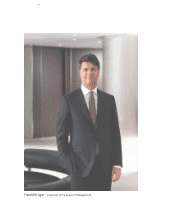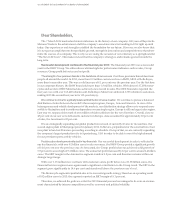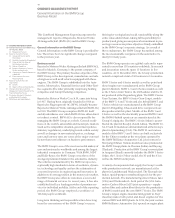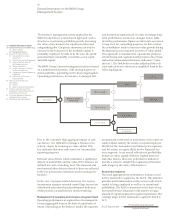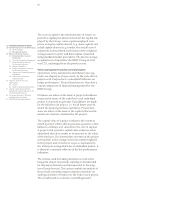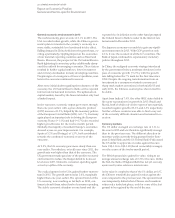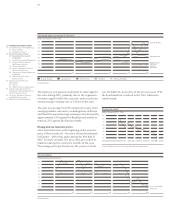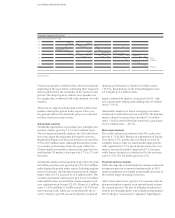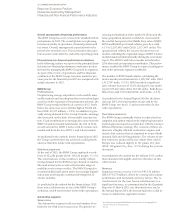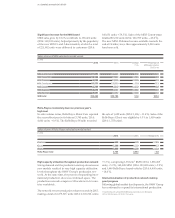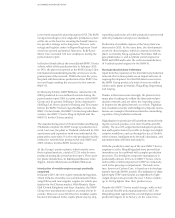BMW 2015 Annual Report Download - page 23
Download and view the complete annual report
Please find page 23 of the 2015 BMW annual report below. You can navigate through the pages in the report by either clicking on the pages listed below, or by using the keyword search tool below to find specific information within the annual report.23 COMBINED MANAGEMENT REPORT
General economic environment in 2015
The world economy grew at a rate of 3.1 % in 2015. The
USA recorded robust growth, while the Chinese govern-
ment’s
plan to transform the country’s economy to a
more stable, sustainable level continued to take effect.
Falling demand in China held down the growth rate, ex-
erting a particularly crippling impact on the economies
of raw material exporting countries such as Brazil and
Russia. Moreover, the prospect of the US Federal Reserve
Bank tightening its monetary policy additionally damp-
ened the outlook for emerging economies. These factors
resulted in further capital outflows, lower investment
and currency devaluation in many developing countries.
Despite signs of a resurgence of Greece’s problems, mar-
kets in the eurozone continued to recover.
After some initial doubt regarding the robustness of the
economy, the US Federal Reserve Bank set the expected
interest rate turnaround in motion. The upheavals on
capital markets feared by the financial market only had
a limited impact.
In the eurozone, economic output grew more strongly
than one year earlier, with a gross domestic product
(GDP) increase of 1.5 %, helped by the monetary policies
of the European Central Bank (ECB). At 1.7 %, Germany
again played an important role in driving the European
economy. France (+ 1.1 %) and Italy (+ 0.7 %) also recorded
higher growth rates for the twelve-month period.
Similarly, the majority of southern Europe’s economies
showed a year-on-year improvement. For example,
Spain at 3.2 % and Portugal, at 1.5 %, both contributed
towards the continued economic recovery of the
euro
zone.
At 2.2 %, the UK economy grew more slowly than one
year earlier. Nevertheless, as in all years since 2011, the
growth rate was higher than that of the eurozone. The
UK government made good use of the positive economic
environment to reduce the budget deficit to its lowest
level since 2007. Domestic consumer spending again
served as a pillar of the economy.
The cyclical upturn in the USA gained further momen-
tum
in 2015. The growth rate stood at 2.4 %, marginally
higher than one year earlier. The upward trend of the
US economy, now reaching as far back as 2010,
con-
tinues to benefit from robust levels of consumer spending
.
The stable economic situation on one hand and the
expected rise in inflation on the other hand prompted
the Federal Reserve Bank to usher in the interest rate
turnaround in December 2015.
The Japanese economy was unable to gain any signifi-
cant
momentum in 2015. With GDP growth at only
0.6 %, it was the weakest of all the G7 countries. The
Bank of Japan continued its expansionary monetary
policies throughout 2015.
In China, the realigned economic strategy introduced
by the government led to a moderate slowdown in the
pace of economic growth (+ 6.9 %), with the growth
rate
falling below the 7 % mark for the first time since
1990. Despite the ongoing transformation from an
investment to a consumer-oriented economy and
sharp
stock market corrections in both mid-2015 and
early 2016, the Chinese economy has shown itself to
be
stable.
Apart from India at 7.4 %, the other BRIC states failed to
live up to expectations for growth in 2015. Brazil and
Russia, both of which rely on the export of raw materials,
recorded negative growth of 3.6 % and 3.8 % respectively.
Neither of these countries was able to find a way out
of the currently difficult situation and remained in re-
cession.
Currency markets
The US dollar averaged an exchange rate of 1.11 to
the euro in 2015 and was therefore significantly stronger
than in the previous year. The different direction in
monetary policy currently being pursued by the
Euro-
pean Central Bank and the US Federal Bank (Fed) caused
the US dollar to appreciate in value against the euro
from US$ 1.16 to US$ 1.09 (based on monthly averages)
over the course of the twelve-month period.
The British pound also gained in value, rising to an
average annual exchange rate of 0.73 to the euro. Unlike
the Fed, the Bank of England (BoE) has not yet seen any
acute need to raise reference interest rates.
As its value is coupled to that of the US dollar, at 6.97,
the Chinese renminbi also gained in value against the
euro compared to the previous year. The upward trend
was temporarily halted when Chinese stock markets
witnessed a turbulent phase, only for some of the lost
ground to be regained by the end of the year.
Report on Economic Position
General and Sector-specific Environment



